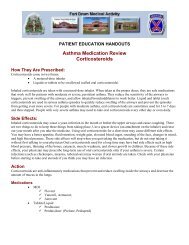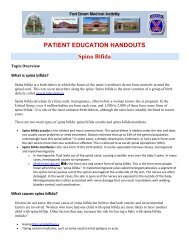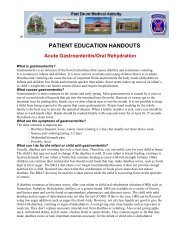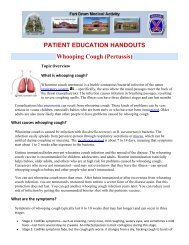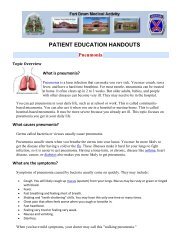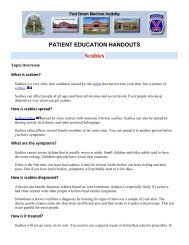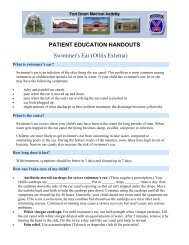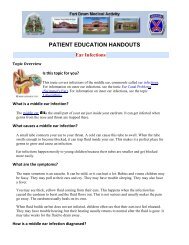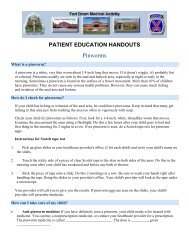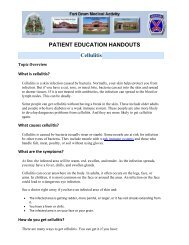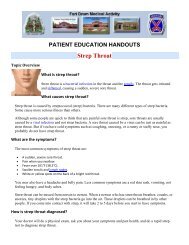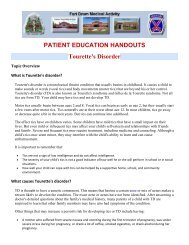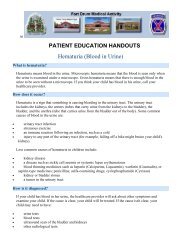PATIENT EDUCATION HANDOUTS Sleep Apnea
PATIENT EDUCATION HANDOUTS Sleep Apnea
PATIENT EDUCATION HANDOUTS Sleep Apnea
You also want an ePaper? Increase the reach of your titles
YUMPU automatically turns print PDFs into web optimized ePapers that Google loves.
<strong>PATIENT</strong> <strong>EDUCATION</strong> <strong>HANDOUTS</strong><br />
<strong>Sleep</strong> <strong>Apnea</strong><br />
Topic Overview<br />
What is sleep apnea<br />
<strong>Sleep</strong> apnea means that you often stop breathing for 10 seconds or longer during sleep. The problem can be<br />
mild to severe, based on the number of times each hour that you stop breathing or how often your lungs<br />
don't get enough air. This may happen from 5 to 50 times an hour.<br />
This topic focuses on obstructive sleep apnea, which is the most common type.<br />
A less common type of apnea, called central sleep apnea, can occur in people who have had a stroke, have<br />
heart failure, or have a brain tumor or infection. Even though this topic isn't about central sleep apnea,<br />
some of the treatments discussed here may also help treat it. Talk with your doctor to find out more about<br />
central sleep apnea.<br />
What causes obstructive sleep apnea<br />
Blocked or narrowed airways in your nose, mouth, or throat can cause sleep apnea. Your airway can<br />
become blocked when your throat muscles and tongue relax during sleep.<br />
<strong>Sleep</strong> apnea can also occur if you have large tonsils or adenoids or a large uvula. During the day, when you<br />
are awake and standing up, these may not cause problems. But when you lie down at night, they can press<br />
down on your airway, narrowing it and causing sleep apnea. <strong>Sleep</strong> apnea can also occur if you have a<br />
problem with your jawbone.<br />
In children, the main cause of sleep apnea is large tonsils or adenoids .<br />
<strong>Sleep</strong> apnea is more likely to occur if you are overweight, use certain medicines or alcohol before bed, or<br />
sleep on your back.<br />
See pictures of normal and blocked airways<br />
during sleep.<br />
What are the symptoms<br />
The main symptoms of sleep apnea that you may notice are:<br />
• Being so sleepy during the day that you fall asleep while working or driving.<br />
• Feeling tired in the morning.<br />
• Waking up with a headache.<br />
Your bed partner may notice that while you sleep:
• You stop breathing.<br />
• You often snore loudly.<br />
• You gasp or choke.<br />
• You toss and turn.<br />
Children who have sleep apnea:<br />
• Nearly always snore.<br />
• May have a hard time breathing during sleep.<br />
• May be restless during sleep and wake up often.<br />
But children may not seem very sleepy during the day (a key symptom in adults). The only symptom of<br />
sleep apnea in some children may be that they do not grow as quickly as most children their age.<br />
Should you worry about sleep apnea<br />
If you have sleep apnea, you may not be sleeping as well as you could. And you may be more likely to end<br />
up with serious problems such as:<br />
• High blood pressure.<br />
• High blood pressure in your lungs.<br />
• An abnormal heart rhythm, heart failure, coronary artery disease (CAD), or stroke.<br />
• Depression.<br />
How is sleep apnea diagnosed<br />
Your doctor will probably examine you and ask about your past health. He or she may also ask you or your<br />
sleeping partner about your snoring and sleep behavior and how tired you feel during the day.<br />
Your doctor may suggest a sleep study. A sleep study usually takes place at a sleep center, where you will<br />
spend the night. <strong>Sleep</strong> studies find out how often you stop breathing or have too little air flowing into your<br />
lungs during sleep. They also find out how much oxygen you have in your blood during sleep. You may<br />
have blood tests and X-rays.<br />
How is it treated<br />
You may be able to treat mild sleep apnea by making changes in how you live and the way you sleep. For<br />
example:<br />
• Lose weight if you are overweight.<br />
• <strong>Sleep</strong> on your side and not your back.<br />
• Avoid alcohol and medicines such as sedatives before bed.<br />
If you have moderate to severe sleep apnea, you may be able to use a machine that helps you breathe while<br />
you sleep. This treatment is called continuous positive airway pressure, or CPAP (say “SEE-pap”).<br />
Sometimes medicine that helps you stay awake during the day may be used along with CPAP. If CPAP<br />
doesn't work, or if your tonsils, adenoids, uvula, or other tissues are blocking your airway, your doctor may<br />
suggest surgery to open your airway.<br />
Frequently asked questions<br />
Learning about obstructive sleep apnea<br />
• What is obstructive sleep apnea<br />
• What are mild, moderate, and severe sleep apnea
(OSA): • What causes it<br />
• Can I prevent sleep apnea<br />
• What are the symptoms<br />
• What happens in sleep apnea<br />
• What increases my risk<br />
• Who gets sleep apnea<br />
Being diagnosed:<br />
• Who can diagnose sleep apnea<br />
• How is sleep apnea diagnosed<br />
• What is a sleep study<br />
• Should I have a sleep study to diagnose sleep<br />
apnea<br />
Getting treatment:<br />
• How is sleep apnea treated<br />
• What is continuous positive airway pressure (CPAP)<br />
• What medicines will I need to take<br />
• Will I need surgery<br />
• What other treatment is available<br />
• Should I have surgery for sleep apnea<br />
Living with sleep apnea:<br />
• What can I do at home for sleep apnea<br />
• What problems can it cause<br />
Author: Maria G. Essig, MS, ELS Last Updated: July 13, 2007<br />
Medical Review: Caroline S. Rhoads, MD ‐ Internal Medicine<br />
Jan Ulfberg, MD, PhD ‐ <strong>Sleep</strong> Disorders<br />
______________________________________________<br />
Reviewed 9 June 2008



